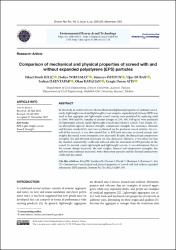Comparison of Mechanical and Physical Properties of Screed with and without Expanded Polystyrene (EPS) Particles

Göster/
Erişim
info:eu-repo/semantics/openAccessTarih
2022Yazar
Kılıç, Fikret MerihYorulmaz, Hediye
Özuzun, Sümeyye
Durak, Uğur
İlkentapar, Serhan
Karahan, Okan
Atiş, Cengiz Duran
Üst veri
Tüm öğe kaydını gösterÖzet
In this study, in order to observe the mechanical and physical properties of ordinary screed, sandy-lightweight screed and lightweight screed samples, expanded polystyrene (EPS) was used as fine aggregate and lightweight screed systems were produced by replacing sand at 100%, 50% and 0%. Samples of cement dosages of 250, 300, 350 kg/m3 were produced for lightweight screeds, sandy-lightweight screeds and ordinary screeds. Unit weight, water absorption capacity, flexural strength, compressive strength, fire resistance, abrasion and thermal conductivity tests were performed on the produced screed systems. As a result of the research, it was determined that as EPS ratio increases in screed system; unit weights decreased, water absorption rates increased. Besides, the flexural and compressive strengths, fire and abrasion resistance are also decreased. However, it was observed that the thermal conductivity coefficient reduced with the increment of EPS particles in the screed. In normal, sandy-lightweight and lightweight screeds, it was determined that as the cement dosage increased; the unit weights, flexural and compressive strengths, fire and abrasion resistance increased, water absorption capacity and the thermal conductivity coefficient decreased.

















